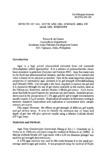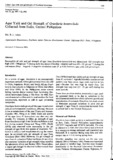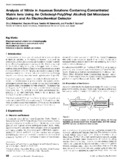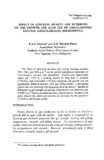Effects of gel depth and gel surface area on agar gel strength
Share
Abstract
Agar is a high priced phycocolloid extracted from red seaweeds (Rhodophyta) called agarophytes. It is a mixture of polysaccharides whose basic monomer is galactose (Armisen and Galatas 1987). Agar has many uses in the food and pharmaceutical industry, and the measure of its commercial value is based on its physical properties. One of the most important physical properties of commercial agar products is its gel strength (Chandrkrachang and Chinadit 1988). Gel strength is the force required to rupture the gel and it is measured through the use of gel testers available in the market, such as the Nikkan-sui, Rowerbal, and the Marine Colloids gel testers. Each instrument has built-in specifications for optimum use and results. Standard procedures used in the preparation of 1.5% agar gels for gel strength determination usually require 1.5 g of sample. Replication of samples in laboratory testing is however standard requirement and replication is constrained when sample extracts are scarce.
This paper discusses the effects on gel strength of different gel depths and gel surface areas. It aims to identify the minimum size of vessel and depth of gel that will give optimum results using a Marine Colloids Model GT-2 gel tester.
Suggested Citation
de Castro, T. R. (1993). Effects of gel depth and gel surface area on agar gel strength. The Philippine Scientist , 30, 100-103. http://hdl.handle.net/10862/1411
Subject
Collections
- AQD Journal Articles [1221]
Related items
Showing items related by title, author, creator and subject.
-
Agar yield and gel strength of Gracilaria heteroclada collected from Iloilo, Central Philippines
Luhan, Maria Rovilla J. (Walter de Gruyter, 1992)Seasonality of yield and gel strength of agar from Gracilaria heteroclada was determined. Gel strength was high (510-794 gm cm-2) during early dry season (October-March) and low (43-101 gm cm-2) during ... -
Analysis of nitrite in aqueous solutions containing concentrated matrix ions using an octadecyl-poly(vinyl alcohol) gel microbore column and an electrochemical detector
Rokushika, Souji; Kihara, Kazuko; Yamamoto, Fumiko M.; Subosa, Precilla F. (Dr. Alfred Huethig Publishers, 1991)The importance of the analysis of low level nitrite concentrations in aqueous samples is increasing in various fields such as environmental, food, and aquaculture chemistry. Recent progress in ion chromatography paved the ... -
Effect of stocking density and nutrients on the growth and agar gel of Gracilariopsis bailinae (Gracilariales, Rhodophyta)
Chavoso, E. A. J.; Hurtado-Ponce, Anicia Q. (San Carlos Publications, University of San Carlos, 1995)The effect of additional nutrients and varying stocking densities (500, 1000, and 2000 g m-2) on the growth and physical properties of Gracilariopsis bailinae was determined. Growth was significantly higher (L ...





